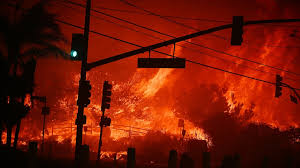Los Angeles County is grappling with one of the most destructive wildfire outbreaks in its history. Four major fires have ravaged the region, resulting in the tragic loss of 16 lives, the destruction of over 38,000 acres of land, and severe damage to at least 10,000 structures. The fires have forced more than 166,000 residents to evacuate their homes as strong winds continue to fuel the flames and hinder firefighting efforts.
Amid this crisis, the Los Angeles Fire Department (LAFD) is under intense scrutiny. Critics have targeted Fire Chief Kristin Crowley over the department’s focus on diversity, equity, and inclusion (DEI) initiatives and the impact of a recent $17.4 million budget cut for the 2025 fiscal year. These cuts, approved as part of the city’s nearly $13 billion budget, have raised concerns about the department’s ability to effectively respond to large-scale emergencies.
Chief Crowley has voiced her frustration with the budget reductions, noting that the cuts have severely compromised the department’s operational capabilities. In a December memo, Crowley highlighted that reductions in funding have adversely affected core operations such as technology upgrades, communication systems, payroll processing, training, fire prevention, and community outreach programs. Particularly alarming was the $7 million reduction in overtime staffing, known as v-hours, which has significantly hindered the department’s ability to prepare for and respond to emergencies.
Over 100 fire apparatus are currently out of service due to staffing shortages and a lack of maintenance personnel. Crowley emphasized that the budget cuts led to the elimination of civilian positions, including mechanics responsible for maintaining essential firefighting equipment. This shortage has severely impacted the department’s capacity to repair and deploy critical firefighting resources during this unprecedented wildfire emergency.
Crowley has made multiple requests for interim budget adjustments to demonstrate how understaffed and underfunded the LAFD has become. According to department data, Los Angeles needs 62 additional fire stations to meet current demand. Since 2010, the department has experienced a 55% increase in emergency call volume while operating with fewer firefighters.
Los Angeles Fire Commission President Genethia Hudley-Hayes defended local officials against criticism, stating that it is inappropriate to blame any individual for the scale of the disaster. Hudley-Hayes acknowledged that while budget constraints posed challenges, the intensity of the fires, driven by extreme weather conditions, would have been difficult to manage even with a fully funded department.
Mayor Karen Bass, who approved the budget cuts, has also come under fire for her decision-making. Some critics argue that the budget reductions weakened the city’s disaster response capabilities, while others point out that funding was reallocated to firefighter salary increases and other operational areas. Despite the controversy, city officials maintain that the LAFD’s overall funding has increased compared to previous years, although the department’s operational budget saw a slight decrease from 2024.
Internal leadership challenges within the LAFD have further complicated the department’s response efforts. Robert Hawkins, president of the Los Angeles City Stentorians, an organization advocating for Black firefighters, criticized the department’s leadership for a lack of clear direction. Hawkins pointed to frequent turnover in senior leadership roles, inadequate firefighter training, and logistical issues such as firefighters being sent home due to a shortage of available fire engines.
The department’s emphasis on diversity and inclusion has also sparked debate. Chief Crowley, the first woman and LGBTQ individual to lead the LAFD, has prioritized fostering a more diverse and inclusive workforce. Under her leadership, the department established the Office of Equity and Human Resources, resulting in more diverse recruitment classes. However, Hawkins contends that the department still struggles with equitable treatment and advancement opportunities for Black firefighters, who make up roughly 11% of the LAFD workforce.
Some critics have linked the department’s focus on DEI initiatives to operational shortcomings. Public figures have suggested that prioritizing diversity over logistical preparedness may have contributed to the department’s challenges during the wildfires. However, others argue that a diverse fire department enhances community trust and effectiveness, as firefighters who reflect the community’s demographics can better understand and respond to residents’ needs.
Additionally, concerns about water supply infrastructure have surfaced. Reports revealed that a nearby reservoir was undergoing repairs and was empty during the fires, complicating firefighting efforts. This revelation prompted California Governor Gavin Newsom to call for an independent investigation into the water supply failures, emphasizing the need to understand how such critical infrastructure could be compromised during a disaster.
Despite the criticism, fire officials stress that the scale and intensity of the wildfires present challenges that may have been insurmountable under any circumstances. Strong winds and dry conditions have accelerated the fires’ spread, overwhelming firefighting crews and resources. Hudley-Hayes reiterated that the focus should remain on supporting affected residents rather than assigning blame.
As Los Angeles County continues to battle the devastating wildfires, the situation underscores the critical need for adequate funding, strategic leadership, and resilient infrastructure. The ongoing crisis has exposed vulnerabilities in the region’s disaster preparedness and response systems, raising urgent questions about how the city can better protect its residents from future catastrophes.

